Re-Os Isotope Characteristics of the Huize Ultra-large Lead-Zinc Deposit, Northeastern Yunnan Province: Constraints on the Himalayan Metallogenic Dynamic Background
-
摘要: 会泽超大型铅锌矿是滇东北铅锌多金属成矿域中典型的密西西比河谷型(MVT)或会泽型(HZT)矿床,因其独特的成矿系统以及矿床中富锗而被地质学者熟知,由于该类型矿床成矿温度较低且缺少合适的定年矿物,其成矿时代一直存在较大的争议。本文在会泽铅锌矿麒麟厂矿区1584中段0-11号穿脉坑道块状铅锌硫化物矿石中挑选了9件硫化物样品(黄铁矿、方铅矿和闪锌矿),采用负离子热表面电离质谱法进行Re-Os同位素分析,获得Re-Os等时线年龄为40.7±2.6 Ma(n=9),与模式年龄加权平均值40.0±2.6 Ma(n=8)在误差内完全一致,闪锌矿和方铅矿模式年龄分别为38.24±0.41 Ma和36.57±0.40 Ma。上述同位素年龄揭示了会泽超大型铅锌矿的成矿时代可能为始新世。结合滇东北铅锌矿集区NE向逆冲断层和冲断褶皱控矿构造区域构造解析以及断裂、矿体构造-岩相蚀变特征,提出会泽超大型铅锌矿经历了燕山期、喜山期两阶段构造-流体贯入的成矿作用模型。
-
关键词:
- 滇东北 /
- 会泽铅锌矿床 /
- 区域构造解析 /
- Re-Os同位素年代学
要点(1) 初始187Os/188Os值指示会泽大型铅锌矿床铁、锌和铅等成矿物质来源于壳幔混源。
(2) 黄铁矿、方铅矿和闪锌矿Re-Os等时线年龄显示会泽大型铅锌矿形成于始新世。
(3) 会泽超大型铅锌矿经历了燕山期、喜山期两阶段构造-流体贯入成矿作用。
HIGHLIGHTS(1) Initial 187Os/188Os values of pyrite, galena, and sphalerite samples indicate that metallogenic materials such as Fe, Zn, and Pb derive from the mixture of crust and mantle materials.
(2) The Re-Os isochron age of pyrite, galena, and sphalerite samples indicate that the metallogenic age of the Huize ultra-large lead-zinc deposit is the Eocene period.
(3) The Huize ultra-large lead-zinc deposit experienced two stages of tectonic-fluid penetration mineralization in the Yanshanian and Himalayan periods.
Abstract:BACKGROUNDThe Huize ultra-large lead-zinc deposit is a typical MVT or HZT type deposit in the lead-zinc polymetallic belt. This deposit is known as a unique metallogenic system and germanium enrichment. Due to the low mineralization temperature and lack of suitable dating minerals, the age of the ore deposits has been controversial.OBJECTIVESTo precisely date the mineralization age by Negative Thermal Ionization Mass Spectrometry (NTIMS) Re-Os isotope analyses and discuss the Himalayan metallogenic dynamic process in the Huize ultra-large lead-zinc deposit.METHODSNTIMS Re-Os isotope analyses were carried out on pyrite, galena, and sphalerite samples collected from the Huize ultra-large lead-zinc deposit. The Re-Os isochron age from the pyrite, galena, and sphalerite samples was used to constrain mineralization age. The initial 187Os/188Os values were used to trace the material sources.RESULTSThe Re-Os isochron age of the pyrite samples is 40.7±2.6 Ma (2σ, n=9) with a model weighted average age of 40.0±2.6 Ma (2σ, n=8). The sphalerite and galena samples have model ages of 38.24±0.41 Ma and 36.57±0.40 Ma, respectively. Furthermore, the initial 187Os/188Os values of the pyrite samples vary from 0 to 0.26, whereas those of the sphalerite and galena samples are 0.46 and 0.41, respectively.CONCLUSIONSThe Re-Os isochron ages indicate that the mineralization for the Huize ultra-large lead-zinc deposit occurred during the Eocene period. Based on regional ore controlling structure, tectono-lithofacies alteration characteristics in Northeastern Yunnan and the isochron ages results, a two-stage (Yanshanian and Himalayan) tectonic-fluid metallogenic model for the Huize Ultra-large lead-zinc deposit is inferred.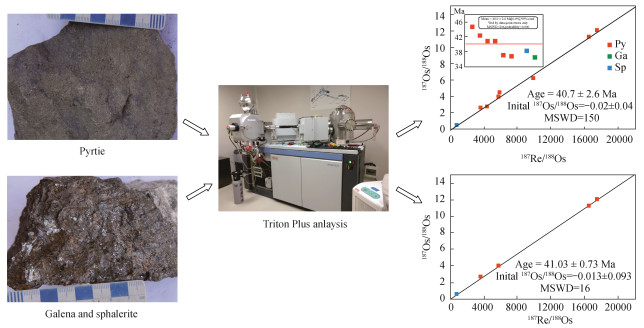
-
滇东北铅锌多金属成矿域是我国重要的铅、锌、银、锗产地之一,以及第四大具有巨大找矿前景的铅锌基地,蕴藏着440多个铅锌多金属矿床(点)和矿化点,其中超大型矿床1个、大型矿床4个、中-小型矿床21个(图 1a)。近年来,随着茂租、会泽和昭通等大型-超大型深部找矿的重大突破,特别是川南天宝山中-大型铅锌矿床深部发现可能为喜山期铜成矿作用,这些引起了国内外地质学家的广泛关注。前人对于川滇黔铅锌矿集区研究主要集中在矿床成因[1-7]、成矿构造背景[8-12]、成矿年代[9, 13-21]、成矿流体来源[8, 22-25]、控矿构造[11]和成矿预测[26-29]等方面。
![]() 图 1 滇东北矿集区区域大地构造简图(a)及会泽超大型铅锌矿地质简图(b)(a)“红框”为研究区位置; (b)地质简图据1: 2.5万会泽铅锌矿区域地质图修改。
图 1 滇东北矿集区区域大地构造简图(a)及会泽超大型铅锌矿地质简图(b)(a)“红框”为研究区位置; (b)地质简图据1: 2.5万会泽铅锌矿区域地质图修改。
(a)铅锌矿床名称:1—天宝山中-大型;2—小石房大型;3—大梁子大型矿床;4—巧家松梁中型;5—茂租大型;6—金沙厂中-大型矿床;7—昭通彝良大型;8—会泽超大型;9—赫章中型;10—垭都中型矿床;11—富乐厂大型;12—赤普中型;13—乐马厂中型银铅锌矿;14—兰坪金顶超大型铅锌矿。断裂名称:1—小江断裂;2—紫云-亚都断裂;3—师宗-弥勒断裂;4—金牛厂-矿山厂-麒麟厂断裂;5—毛坪-迤车-五星厂断裂;6—白牛厂-放马坝断裂;7—茂租-金沙厂断裂。
(b)断裂名称:F1—矿山厂逆断裂;F2—麒麟厂逆断裂;F3—银厂坡逆断裂。图例:1—震旦系灯影组;2—晚泥盆统宰格组1段;3—晚泥盆统宰格组2段;4—晚泥盆统宰格组3段;5—早石炭统大塘组;6—早石炭统摆佐组;7—晚石炭统威宁组;8—晚石炭统马坪组;9—早二叠统龙山组;10—中二叠统栖霞-茅口组;11—晚二叠统峨眉山玄武岩;12—断层;13—铅锌矿体。Figure 1. (a) Tectonic map of lead-zinc polymetallic domain of Northeastern Yunnan Province and (b) Geological map of the Huize ultra-large lead-zinc deposit虽然川滇黔铅锌多金属成矿域在上述方面取得了很多成果,但其成矿时代一直存在很大争议,主要有以下不同种观点:①依据地质特征和铅同位素组成认为该区存在多期成矿[2-3, 29-30];②依据会泽铅锌矿床闪锌矿和方解石的Rb-Sr及Sm-Nd同位素年龄(224~226 Ma), 认为主成矿期为印支期[13-15];③依据跑马、天桥、沙厂、大梁子和茂租矿床硫化物Rb-Sr法,获得成矿年龄191~204 Ma, 认为主成矿期为早侏罗世[16-18];④依据会泽麒麟厂矿床北东向冲断褶皱卷入了中侏罗世遂宁组地层的现象以及该矿床的伊利石K-Ar年龄(176 Ma)和赤普铅锌矿床中与成矿相关的沥青Re-Os年龄(165.7 Ma),认为铅锌矿床形成于燕山早-中期[7, 9, 18]。综上所述,前人对川滇黔成矿域成矿年代的认识仍存在较大的争议,究其原因,是因为该地区的铅锌矿床多为低温“构造-流体-贯入”碳酸盐岩型铅锌矿床,缺少可以直接用于同位素定年的矿物,区域构造解析也不明晰。
不仅是川滇黔地区的铅锌矿床,在全世界范围,铅锌成矿时代的精确厘定都是矿床学研究的一大难题,很多学者尝试了多种方法对铅锌矿床开展年代学研究,大多数铅锌矿成矿时代主要通过与成矿有关共伴生矿物年龄间接推测,如伊利石K-Ar法[9]、成矿期方解石Sm-Nd法[15]、成矿期萤石U-Pb、Th-Pb法[31-34]和闪锌矿Rb-Sr法[35]等测年方法以及古地磁法[34]。虽然取得一些测年数据,但是很多学者对铅锌矿形成时代仍存在疑虑。本文对滇东北铅-锌多金属成矿域典型的会泽超大型铅锌矿床开展硫化物负离子热表面电离质谱法(NTIMS)Re-Os同位素定年,结合滇东北铅锌多金属成矿域区域构造解析特征,旨在确定会泽铅锌矿床成矿时代、铅锌多金属成矿作用与青藏高原东南缘陆内构造转换造山作用耦合关系,进而为掌握该区域成矿的时空结构和矿床的形成及分布规律,建立区域成矿模式和找矿模型等提供支撑。
1. 矿床地质背景
会泽超大型铅锌矿床是滇东北铅锌矿集区典型代表,其位于扬子板块西南缘板块内部,SN向小江走滑深断裂、NW向紫云亚都隐伏断裂与NE向逆冲断裂构造带的构造复合部位(图 1a),NE向逆冲断裂带和侏罗山式褶皱属华南中生代NE向太平洋构造域远程作用产物,主要包括师宗—弥勒断裂、金牛厂—矿山厂—麒麟厂断裂、毛坪—迤车—五星厂断裂、白牛厂—放马坝断裂和茂租—金沙厂断裂,SN向小江断裂和NW向紫云亚都断裂为青藏高原后碰撞阶段物质向东南逃逸导致扬子板块西缘发生旋转调节作用结果。
区域上主要出露元古界昆阳群(东川群)变质褶皱基底、新元古代大陆裂谷背景澄江群、震旦系—晚志留统台地海相碎屑岩-碳酸盐岩沉积层、泥盆系—中晚侏罗统伸展背景台地-陆相碳酸盐岩-碎屑岩沉积层、白垩系陆相红层以及新生代陆相磨拉石沉积层等6个构造层,各个构造层以典型不整合所隔开,不整合分别代表研究区存在晋宁、澄江、加里东、燕山和喜山期5次构造运动,其中泥盆系—中晚侏罗统构造层内峨眉山玄武岩(P2β)与早二叠统栖霞—茅口组(P1q+m)灰岩存在因地幔柱隆升形成的喷发不整合,但区域上缺失前人广泛认为的印支期冲断褶皱造山形成角度不整合即中-晚三叠世沉积间断缺失(图 2)。区域上出露岩浆岩主要为新元古代花岗岩、晚二叠世峨眉山玄武岩和喜山期(36~11 Ma)富碱钾质-超钾质斑岩和碳酸岩-正长岩杂岩。
会泽铅锌矿床赋存于矿山厂—金牛厂和麒麟厂北东向主构造断裂带北段上盘,主要包括矿山厂和麒麟厂矿段,是川滇黔多金属成矿域典型的富锗铅锌(银)矿床(田)(图 1b)。研究区北东向褶皱卷入了最晚地层为侏罗统遂宁组地层,并结合会泽麒麟厂矿体层间滑动形成的伊利石K-Ar法坪年龄176 Ma,认为NE向冲断-褶皱主构造(控矿构造,如矿山厂、麒麟厂和银厂坡)形成时代为晚侏罗世—早白垩世,且发育NW向喜山期走滑伸展断裂(破矿构造,如东头断裂)。矿区主要发育震旦系、寒武系、中-上泥盆统、石炭系和二叠系地层,前人认为赋矿围岩地层为早石炭统摆佐组(C1b),为一套白云岩地层。项目组对矿体围岩、地表和外围赋矿地层及蚀变特征进行研究,认为早石炭统摆佐组(C1b)为细晶白云岩、灰质白云岩,而矿体围岩粗晶白云岩其为摆佐组上覆晚石炭世威宁组(C2w)生物碎屑或生物礁灰岩受构造-热液流体交代作用形成(图 3b),晚石炭世威宁组构造热液蚀变粗晶白云岩为会泽铅锌矿区外围及深部今后找矿方向。矿石主要呈致密块状,品位较高(Pb+Zn为30%~35%),局部高达60%,伴生Ag、Ge、Cd、Ga、In等分散元素矿种,矿石矿物主要由闪锌矿、方铅矿、黄铁矿组成,脉石矿物较少,主要为方解石和白云石。
2. 实验部分
2.1 样品特征
本研究Re-Os同位素测年样品主要采至麒麟厂1584中段0-11号穿脉坑道内,主要为富锗等分散元素的块状黄铁矿铅锌矿石,共计9件。矿体与围岩界线起伏,局部地区可见港湾和“火焰状”构造(图 3a)。矿区内粗晶白云岩化为最典型的蚀变现象,矿体由中心向外围蚀变特征为铅锌矿体/矿化带→黄铁矿体/矿化带→灰白色粗晶白云岩带→米黄色粗晶白云岩带→肉红色粗晶白云岩带→大理岩化-粗晶白云岩化灰岩带→星点状白云石化灰岩带等蚀变分带现象。矿山厂断裂和麒麟厂断裂构造-蚀变特征研究显示,断裂带内出现的粗晶白云岩化、黄铁矿化和重晶石化等热液蚀变,与矿体周围蚀变特征相似(图 3c和d)。矿石矿物为黄铁矿、闪锌矿和方铅矿,黄铁矿呈粒状自形-半自形晶产出,具碎裂结构,见正方形及五角十二面体,高硬度。闪锌矿,灰色,解理明显,中等硬度。镜下显微镜特征显示,方铅矿为纯白色,闪锌矿为深灰色,黄铁矿为浅黄色,方铅矿立方解理和三角孔构造发育,较闪锌矿含量低,方铅矿交代共生闪锌矿现象明显。脉石矿物以方解石和白云石为主,沿前期形成的方铅矿、闪锌矿节理裂隙和交代共生边充填,与粗晶黄铁矿为共生关系,被后期细粒黄铁矿交代(图 3e和f),因此判断闪锌矿与方铅矿为共生交代关系。
2.2 样品化学处理流程及测试方法
首先用地质锤将样品袋包好的矿石样品敲碎,将挑选出新鲜的硫化物,再用一次性滤纸包好,用地质锤敲碎至60~80目,然后在双目镜下挑纯,选取其中7件黄铁矿、1件闪锌矿和1件方铅矿样品进行Re-Os同位素测试。
硫化物室内溶解化学流程参照李超等[36],准确称取硫化物样品由细颈漏斗加入到长20 cm、直径2 cm的Carius管底部。用3 mL 15 mol/L盐酸将185Re-190Os混合稀释剂转入用液氮冷冻的Carius管之后,再依次加入5 mL 15 mol/L硝酸和1 mL 30% H2O2,用液化石油气和氧气火焰封闭Carius管,230℃下加热24 h[37-38]。采用Carius管直接蒸馏和微蒸馏法对Os进行分离纯化[39-40],采用丙酮萃取法对Re进行分离富集[40-41]。
采用NTIMS法测定Re和Os同位素比值。将焊好的铂带在空气中以4.5 A的电流去气0.5 h,然后用微量移液器将溶液点在铂带上(每次取0.2 μL),以1 A电流蒸干。全部溶液点带蒸干后,缓慢升高电流至1.5 A,持续1 min赶尽杂质,随后降下电流。用微量移液器取发射剂0.3 μL氢氧化钡溶液点在试样上,以0.6 A电流蒸干,可看到乳白色沉淀覆盖在铂带上。随后缓慢升高电流至乳白色沉淀开始熔化成像冰一样的状态,而后降低电流。采用热表面电离质谱仪(Triton Plus)在负离子模式下,对Re和Os的同位素比值进行测定[42-43]。对TIMS测量数据利用氧同位素自然丰度和等概率模型采用逐级剥谱法扣除氧同位素的干扰。以192Os/188Os=3.0827[44]作为标准值,采用迭代法对Os进行质量分馏校正。
3. 结果与讨论
3.1 硫化物Re-Os测试结果
本次测定的9件黄铁矿、闪锌矿和方铅矿样品Re-Os同位素组成列于表 1,其中普通Os是根据Nier值校正得出Os同位素丰度,借助192Os/190Os测量值计算得出的,187Os为放射成因187Os和初始187Os之和。Re、Os含量的不确定度,是由样品和稀释剂的称量误差、稀释剂的标定误差、质谱测定的分馏校正误差和待分析样品同位素比值测量误差经计算得出;而模式年龄的不确定度计算还包括衰变常数的不确定度(1.02%)。Re-Os同位素模式年龄t的计算公式如下:
$ t = \frac{1}{\lambda }\ln \left( {1{ + ^{{\rm{187}}}}{\rm{Os}}{/^{{\rm{187}}}}{\rm{Re}}} \right) $
表 1 会泽铅锌矿硫化物Re-Os同位素测年数据Table 1. Re-Os isotope data of sulfide samples from the Huize lead-zinc deposit样品编号 样品类型 样品质量(g) Re含量(×10-9) 普Os含量(×10-9) 187Os含量(×10-9) 187Re/188Os 187Os/188Os 模式年龄(Ma) 测定值 不确定度 测定值 不确定度 测定值 不确定度 测定值 不确定度 测定值 不确定度 测定值 不确定度 HZ-1 黄铁矿(Py) 0.30804 12.97 0.04 0.0173 0.0003 0.0058 0.0001 3604 55 2.548 0.056 44.58 0.46 HZ-1-3 黄铁矿(Py) 0.30015 11.32 0.03 0.0095 0.0001 0.0049 0.0000 5746 47 3.927 0.050 42.14 0.43 HZ8-1 黄铁矿(Py) 0.36107 8.979 0.066 0.0025 0.0000 0.0038 0.0000 17461 189 11.96 0.06 40.86 0.45 HZ8-3 黄铁矿(Py) 0.34975 7.384 0.055 0.0022 0.0000 0.0032 0.0000 16499 176 11.20 0.04 40.74 0.42 HZ8-4 黄铁矿(Py) 0.35227 5.276 0.039 0.0026 0.0000 0.0020 0.0000 9926 103 6.122 0.018 37.07 0.38 HZ8-6 黄铁矿(Py) 0.35097 9.573 0.071 0.0106 0.0001 0.0037 0.0000 4357 51 2.661 0.020 36.63 0.43 HZ8-8 黄铁矿(Py) 0.35359 6.920 0.051 0.0057 0.0000 0.0033 0.0000 5902 61 4.503 0.018 45.79 0.47 HZ8-2 方铅矿(Gn) 0.35382 0.296 0.002 0.0022 0.0000 0.0001 0.0000 657.8 6.9 0.4196 0.0013 38.24 0.41 HZ8-7 闪锌矿(Sp) 0.35102 0.308 0.002 0.0019 0.0000 0.0001 0.0000 765.2 7.9 0.4666 0.0022 36.57 0.40 式中:187Re的衰变常数λ=1.666×10-11 a-1[45]。
Re-Os同位素分析全流程空白Re为2 pg,Os为0.1 pg,表 1数据已经扣除了本底对样品的影响。
从会泽超大型铅锌矿床麒麟厂矿段中黄铁矿、闪锌矿和方铅矿Re-Os同位素数据可以看出,黄铁矿的Re含量为5.276×10-9~12.97×10-9,187Os含量为2.0×10-12~5.8×10-12。方铅矿和闪锌矿的Re含量分别为0.3538×10-9和0.3510×10-9,187Os含量都为0.1×10-12。采用Isoplot软件[46]对会泽铅锌矿黄铁矿、闪锌矿和方铅矿Re-Os同位素数据进行投图,获得9件硫化物Re-Os等时线年龄为40.7±2.6 Ma(MSWD=150,n=9)(图 4a),与模式年龄加权平均值40.0±2.6 Ma(2σ,n=8)在误差内完全一致(图 4b),剔除3件离散的硫化物数据,其余6件硫化物获得Re-Os等时线年龄41.03±0.73 Ma(MSWD=16,n=6)(图 4c),1件闪锌矿和1件方铅矿的模式年龄分别为38.24±0.41 Ma和36.57±0.40 Ma。上述同位素年龄揭示会泽超大型铅锌矿床的成矿时代可能为始新世。
3.2 会泽铅锌矿成矿时代分析
浅成低温铅锌矿床精确定年一直是地学界的难题,其矿物组合简单,适合定年的矿物少,通常很难满足定年要求。前人对会泽超大型铅锌矿床进行闪锌矿Rb-Sr法,以及伴生矿物伊利石K-Ar法和方解石Sm-Nd法测年研究,如该矿床1号和6号矿体方解石Sm-Nd等时线年龄为225~226 Ma,闪锌矿Rb-Sr等时线年龄为225.8~226.0 Ma,以及黏土矿物伊利石的K-Ar年龄为176.05 Ma[9, 13, 15-16]。同时,蔺志永等[16]还报道了四川宁南跑马铅锌矿床闪锌矿Rb-Sr等时线年龄为200.1±4.0 Ma,吴越[18]报道了金沙厂铅锌矿萤石和大梁子铅锌矿方解石Sm-Nd等时线年龄分别为201.1 Ma和204.4 Ma,并且认为四川赤普铅锌矿与古油气藏运移密切相关,沥青Re-Os同位素等时线年龄获得两期292 Ma和165.7 Ma,以及张长青等[19]报道了四川大梁子大型铅锌矿床闪锌矿Rb-Sr等时线年龄为366.3±7.7 Ma。上述同位素年龄结果差别较大,很难得到一个被广泛认可的年代学数据。
前人认为滇东北矿集区存在8条NE向冲断褶皱构造带,并且冲断褶皱构造明显控制了矿田展布(矿体位于逆冲断层上覆牵引褶皱带),形成诸如昭通毛坪、乐红、乐马厂以及本文研究的会泽铅锌矿床。前人基于已获得224~226 Ma同位素年龄,认为滇东北铅锌成矿作用主体上发生于印支期,其由于龙门山造山带、南盘江—右江增生弧型冲褶带及哀牢山墨江绿春造山带共同挤压作用形成NE向冲断褶皱带,从而造山带流体大规模运移至冲断褶皱带形成了构造扩容空间,最终成矿物质卸载与沉淀成矿[11]。然而,本课题组仔细查阅和分析研究区及邻区所有1: 20万区域地质调查资料,利用区域构造解析学和大地构造学手段分析研究区的构造演化过程,认为矿区属于稳定扬子地块内部,发育6个构造层,各个构造层以典型角度不整合所隔开,不整合面分别代表 5次构造运动,分别为晋宁运动、澄江运动、加里东运动(地壳抬升非褶皱)、燕山运动和喜山运动,但区域上缺失印支期褶皱造山运动所形成角度不整合(图 2)。印支期南盘江—右江增生弧型冲褶带及哀牢山—绿春造山带影响范围远远未达到研究区,前者影响范围未跨过弥勒—师宗断裂一线,后者影响范围未跨过楚雄盆地东缘地区,这一论点得到滇东北地区泥盆—中晚侏罗世连续沉积或局部平行不整合所证实。
但是滇东北地区NE向冲断褶皱控矿构造形成时代仍然不明确,区域构造解析学和大地构造学对比分析认为研究区与整个华南地区NE向构造特征一致,且包卷震旦系至侏罗系地层和在昭通彝良—牛街地区被白垩系不整合覆盖,说明冲断褶皱构造形成于侏罗系之后白垩系之前(燕山期),为古太平洋向西挤压俯冲作用远程效应作用结果。张长青等[9]通过会泽铅锌矿麒麟矿坑1710中段矿体中层间泥质岩石变质形成的伊利石K-Ar法测年,获得176.5±2.54 Ma,其并不是代表成矿作用时代,而是代表地层纵弯褶皱作用形成层间滑脱断层的时代,这一年龄与区域上构造活动油气运移沥青熟化大致一致[18]。因此,综合上述资料,本研究认为会泽超大型铅锌矿NE向冲断褶皱导矿或控矿构造形成于晚侏罗世—早白垩世,矿床形成应晚于或同期形成NE向冲断褶皱的时代。
本文获得9件黄铁矿、闪锌矿和方铅矿的Re-Os等时线年龄40.7±2.6 Ma(2σ, n=7),与模式年龄加权平均值40.0±2.6 Ma(2σ, n=9)在误差内完全一致。该期成矿事件年龄前人在会泽铅锌矿床(黄铁矿Re-Os同位素年龄32 Ma[21];最年轻一组闪锌矿的Re-Os同位素年龄50~51 Ma[11])和罗平富乐铅锌矿床的闪锌矿Re-Os同位素年龄20.4~34.7 Ma[20]也有报道。并且位于小江断裂北段川西冕宁—德昌地区的牦牛坪、大陆槽、木落寨和里庄REE矿床成矿年龄主要集中于23~28 Ma[47-48]。上述少量的同位素证据似乎说明了滇东北铅锌矿集区明显存在喜山期成矿作用,且与印度与亚洲大陆晚碰撞阶段NS向小江左行走滑主构造密切相关。
上述野外地质特征和零星的Re-Os年龄说明始新世青藏高原隆升物质向东逃逸,导致小江左行走滑断裂作用将深部成矿流体带到地壳上部,侧向运移至燕山期形成NE向冲断褶皱构造,最终成矿物质在合适围岩和空间就位沉淀,形成小江断裂内部和附近广泛分布的大量的断裂型或鸡窝状铅锌矿床或矿化点(跑马、茂租、大梁子等)。
3.3 成矿作用动力学背景讨论
3.3.1 会泽铅锌矿成矿物质来源
关于金属成矿物质来源的研究,一直是解决矿床成因、建立成矿模型的一个重要依据。通常情况下,铅锌矿床一般采用S-Pb同位素来示踪金属成矿物质来源。近些年来,发表的大量金属矿床Re-Os同位素年代学数据,使Re-Os同位素体系中的Re含量和187Os/188Os值成为判断成矿物质来源的主要依据之一。近年来,一些地质学家通过统计大量金属矿床辉钼矿Re-Os年龄数据发现,幔源成因矿床到壳源成因矿床辉钼矿中Re含量呈下降趋势[49-50],并对地幔成因、壳幔混源成因及地壳成因矿床中辉钼矿Re含量进行量化,为n×10-4→n×10-5→n×10-6[51]。然而Re含量控制因素众多,测量值不确定度较大,不能作为物质来源的严格判据[36]。由于Os为亲铁、亲铜元素,在岩浆演化及成矿流体运移过程中,Os与Fe、Cu的行为相近,并且不同的地质端元Os同位素组成差异较大,地幔的187Os/188Os值约为0.12,而平均上地壳的187Os/188Os值约为1,因此常利用Os的来源来反映金属成矿物质来源[36]。与平均上地壳Os同位素特征相比,会泽超大型铅锌矿床中黄铁矿的187Os/188Os初始值0~0.26,由于Re/Os值较大,使得采用等时线年龄扣除187Os中放射性187Os过程中引入了较大误差,但是不难判断,黄铁矿物质来源为壳幔混合。此外,闪锌矿、方铅矿具有相对低(非放射成因)的187Os/188Os值0.41~0.46,这表明铁、锌和铅成矿物质来源为壳幔混源(幔源岩浆、地壳)[52]。
3.3.2 滇东北铅锌矿集区矿床成因及成矿动力学初探
关于滇东北铅锌矿床成因,前人提出不同的观点,如岩浆热液[1]、沉积[53]、沉积-改造[54]、沉积-成岩期后热液改造-叠加[26]、沉积-改造-后成[2]、MVT型[3, 18]、均一化流体贯入成矿[14]、四川—贵州—云南型成矿模型[4-6, 8]以及会泽型[11]等。特别是韩润生等[55]针对滇东北铅锌矿床具有“富(品位特高:Pb+Zn≥25%~35%),大(矿床和矿体的资源储量大),多(共生Ge、Ag、Cd等有价组分),深(矿体垂向延深大),强(铁白云石化、白云石化热液蚀变强烈),带(金属矿物组合与蚀变岩相分带明显),高(成矿温度可高达255~355℃)”等独特的矿床地质特征,这些特征明显不同于国内外已知类型铅锌矿床(如MVT、VHMS、SEDEX等),从而建立了印支期构造-流体贯入成矿模型。然而,基于区域构造解析学、矿区构造-岩相蚀变特征和硫化物Re-Os同位素年龄,我们对于何时何种方式构造-流体贯入成矿提出不同观点。
本研究认为滇东北铅锌矿集区,其铅锌矿床大致分为“容矿空间”和“容矿围岩”两种类型。“容矿空间”矿床典型代表为茂租、大梁子、赫章和天宝山中型铅锌矿床等,一般展布于青藏高原东南缘或扬子西缘内部左行走滑断裂附近(小江断裂和紫云—亚都断裂),矿体就位于断裂作用同期或前期张性的容矿空间,这类矿床多赋存于震旦—寒武系沉积型白云岩地层中,沉积型白云岩岩石“能干性”(岩石变形行为相对差异)较强,利于褶皱和断裂形成矿体就位空间,但不利于成矿流体发生热液交代作用,形成鸡窝状矿体;“容矿围岩”矿床典型代表为会泽矿山厂—麒麟厂—银厂坡、昭通彝良和罗平富乐等超大型铅锌矿床,这类矿床展布于扬子西缘内部NE向冲断褶皱上盘(师宗—弥勒断裂、金牛厂—矿山厂—麒麟厂断裂、毛坪—迤车—五星厂断裂等),多赋存于晚古生代富有机质礁灰岩或生物碎屑灰岩地层[会泽矿区晚石炭统威宁组(C2w)生物礁-生屑灰岩地层],富(Mg2+、Zn2+、Pb2+、Fe2+和SO42-)成矿流体沿NE向断层上升地表选择富有机质生物礁灰岩地层发生强烈的热液交代蚀变作用,珊瑚礁-生屑灰岩围岩中富含CH4等有机质使SO42-还原H2S,从而导致Zn2+、Pb2+沉淀就位,形成致密块状铅锌硫化物矿体并伴生大量的粗晶白云岩围岩蚀变(Mg2+[流体]+CaCO3→CaMg(CO3)2[粗晶白云岩])(图 3a, b)。
综上所述,滇东北矿集区典型的会泽超大型铅锌矿成矿作用时代为始新世,提出了会泽大型铅锌矿形成经历了两阶段构造-流体贯入成矿模型:①早期(中-晚侏罗世,~176 Ma),即NE向主控矿构造形成阶段。滇东北矿集区(会泽铅锌矿区)NE向主控矿断裂和冲断褶皱构造,包括矿山厂、麒麟厂和银厂坡控矿断裂等,与四川盆地东南缘NE向隔挡、隔槽侏罗山式褶皱乃至整个华南NE向构造一致,受控于中-晚侏罗世西太平洋板片深俯冲作用远程效应(图 5a, b);②晚期(喜山期,~40 Ma),即成矿流体就位阶段。在印度/欧亚板块碰撞后期,滇东北矿集区承载着应力转化和调节的功能,在应力挤压和转化过程中,伴随印支中间地块的逃逸,沿扬子西缘小江和紫云—亚都断裂发生大规模走滑,诱使富碱钾质-超钾质壳-幔混源正长岩-碳酸岩岩浆和成矿流体沿NS向小江左行走滑主构造上升地壳上部,成矿流体侧向运移至地表浅部燕山期NE向逆冲断层构造(会泽地区矿山厂、麒麟厂和银厂坡断裂),选择晚石炭统威宁组(C2w)富有机质的生物礁灰岩围岩和断裂空间,最终卸载与贯入沉淀就位成矿(图 5c)。
![]() 图 5 会泽超大型铅锌矿两个阶段构造-流体贯入成矿模型a—中-晚侏罗世之前,缺失印支造山运动;b—燕山期(~176 Ma),北东向冲断-褶皱主构造形成;c—始新世(~40 Ma),成矿流体贯入交代沉淀就位成矿(AB剖面位置见图 1b)。Figure 5. Two stages of structural and fluid injection metallogenic model of the Huize ultra-large lead-zinc deposit
图 5 会泽超大型铅锌矿两个阶段构造-流体贯入成矿模型a—中-晚侏罗世之前,缺失印支造山运动;b—燕山期(~176 Ma),北东向冲断-褶皱主构造形成;c—始新世(~40 Ma),成矿流体贯入交代沉淀就位成矿(AB剖面位置见图 1b)。Figure 5. Two stages of structural and fluid injection metallogenic model of the Huize ultra-large lead-zinc deposit4. 结论
本文基于会泽超大型铅锌矿硫化物Re-Os同位素特征,铅锌矿集区NE向逆冲断层和冲断褶皱主控矿构造区域构造解析以及断裂、矿体构造-岩相蚀变特征等综合研究,认为川滇黔矿集区在印度/欧亚板块碰撞后期(始新世,~40 Ma),承载着应力转化和调节的功能,伴随印支中间地块的逃逸,小江和紫云—亚都断裂发生大规模走滑,诱使富碱钾质-超钾质壳-幔混源正长岩-碳酸岩岩浆和成矿流体沿NS向小江左行和NW向紫云—亚都断裂走滑主构造上升地壳上部,并且成矿流体侧向运移至燕山期NE向逆冲断层构造,选择富有机质的围岩和早期断裂空间卸载与贯入沉淀就位,最终形成川滇黔铅锌多金属成矿域。
本文运用区域构造分析与Re-Os同位素相结合的方法,对更深层次认识川滇黔铅锌成矿域成矿系统和成矿理论具有重要科学价值,以及对深部、外围铅锌资源勘查和进一步开发利用具有指导意义。
致谢: 感谢国家地质实验测试中心屈文俊研究员等专家在低含量硫化物测年和项目支持等方面给予的大力帮助。感谢昆明理工大学韩润生、李峰教授和中国地质调查局成都地质调查中心李文昌教授级高级工程师为论文成文和野外调研提供的大量帮助! -
图 1 滇东北矿集区区域大地构造简图(a)及会泽超大型铅锌矿地质简图(b)
(a)“红框”为研究区位置; (b)地质简图据1: 2.5万会泽铅锌矿区域地质图修改。
(a)铅锌矿床名称:1—天宝山中-大型;2—小石房大型;3—大梁子大型矿床;4—巧家松梁中型;5—茂租大型;6—金沙厂中-大型矿床;7—昭通彝良大型;8—会泽超大型;9—赫章中型;10—垭都中型矿床;11—富乐厂大型;12—赤普中型;13—乐马厂中型银铅锌矿;14—兰坪金顶超大型铅锌矿。断裂名称:1—小江断裂;2—紫云-亚都断裂;3—师宗-弥勒断裂;4—金牛厂-矿山厂-麒麟厂断裂;5—毛坪-迤车-五星厂断裂;6—白牛厂-放马坝断裂;7—茂租-金沙厂断裂。
(b)断裂名称:F1—矿山厂逆断裂;F2—麒麟厂逆断裂;F3—银厂坡逆断裂。图例:1—震旦系灯影组;2—晚泥盆统宰格组1段;3—晚泥盆统宰格组2段;4—晚泥盆统宰格组3段;5—早石炭统大塘组;6—早石炭统摆佐组;7—晚石炭统威宁组;8—晚石炭统马坪组;9—早二叠统龙山组;10—中二叠统栖霞-茅口组;11—晚二叠统峨眉山玄武岩;12—断层;13—铅锌矿体。Figure 1. (a) Tectonic map of lead-zinc polymetallic domain of Northeastern Yunnan Province and (b) Geological map of the Huize ultra-large lead-zinc deposit
图 5 会泽超大型铅锌矿两个阶段构造-流体贯入成矿模型
a—中-晚侏罗世之前,缺失印支造山运动;b—燕山期(~176 Ma),北东向冲断-褶皱主构造形成;c—始新世(~40 Ma),成矿流体贯入交代沉淀就位成矿(AB剖面位置见图 1b)。
Figure 5. Two stages of structural and fluid injection metallogenic model of the Huize ultra-large lead-zinc deposit
表 1 会泽铅锌矿硫化物Re-Os同位素测年数据
Table 1 Re-Os isotope data of sulfide samples from the Huize lead-zinc deposit
样品编号 样品类型 样品质量(g) Re含量(×10-9) 普Os含量(×10-9) 187Os含量(×10-9) 187Re/188Os 187Os/188Os 模式年龄(Ma) 测定值 不确定度 测定值 不确定度 测定值 不确定度 测定值 不确定度 测定值 不确定度 测定值 不确定度 HZ-1 黄铁矿(Py) 0.30804 12.97 0.04 0.0173 0.0003 0.0058 0.0001 3604 55 2.548 0.056 44.58 0.46 HZ-1-3 黄铁矿(Py) 0.30015 11.32 0.03 0.0095 0.0001 0.0049 0.0000 5746 47 3.927 0.050 42.14 0.43 HZ8-1 黄铁矿(Py) 0.36107 8.979 0.066 0.0025 0.0000 0.0038 0.0000 17461 189 11.96 0.06 40.86 0.45 HZ8-3 黄铁矿(Py) 0.34975 7.384 0.055 0.0022 0.0000 0.0032 0.0000 16499 176 11.20 0.04 40.74 0.42 HZ8-4 黄铁矿(Py) 0.35227 5.276 0.039 0.0026 0.0000 0.0020 0.0000 9926 103 6.122 0.018 37.07 0.38 HZ8-6 黄铁矿(Py) 0.35097 9.573 0.071 0.0106 0.0001 0.0037 0.0000 4357 51 2.661 0.020 36.63 0.43 HZ8-8 黄铁矿(Py) 0.35359 6.920 0.051 0.0057 0.0000 0.0033 0.0000 5902 61 4.503 0.018 45.79 0.47 HZ8-2 方铅矿(Gn) 0.35382 0.296 0.002 0.0022 0.0000 0.0001 0.0000 657.8 6.9 0.4196 0.0013 38.24 0.41 HZ8-7 闪锌矿(Sp) 0.35102 0.308 0.002 0.0019 0.0000 0.0001 0.0000 765.2 7.9 0.4666 0.0022 36.57 0.40 -
谢家荣.云南矿产概论[J].地质论评, 1941(增刊):1-42. http://www.wanfangdata.com.cn/details/detail.do?_type=perio&id=QK000000369343 Xie J R.An introduction to the mineral resources in Yunnan Province[J].Geological Review, 1941(Supplement):1-42. http://www.wanfangdata.com.cn/details/detail.do?_type=perio&id=QK000000369343
柳贺昌, 林文达.滇东北铅锌银矿床规律研究[M].昆明:云南大学出版社, 1999:1-419. Liu H C, Lin W D.Regularity Research of Ag-Zn-Pb Ore Deposits North-East Yunnan Province[M].Kunming:Yunnan University Press, 1999:1-419.
张长青. 中国川滇黔交界地区密西西比型(MVT)铅、锌矿床成矿模型[D]. 北京: 中国地质科学院, 2008. Zhang C Q. The Model of Mississippi Valley-type (MVT) Lead and Zinc Deposits in the Junction of Sichuan-Yunnan-Guizhou Provinces[D]. Beijing: Chinese Academy of Geological Sciences, 2008.
Zhou J X, Huang Z L, Bao G P.Geological and sulfur-lead-strontium isotopic studies of the Shaojiwan Pb-Zn deposit, Southwest China:Implications for the origin of hydrothermal fluids[J].Journal of Geochemical Exploration, 2013, 128(2):51-61. https://linkinghub.elsevier.com/retrieve/pii/S0375674213000216
Zhou J X, Huang Z L, Yan Z F.The origin of the Maozu carbonate-hosted Pb-Zn deposit, Southwest China:Constrained by C-O-S-Pb isotopic compositions and Sm-Nd isotopic age[J].Journal of Asian Earth Sciences, 2013, 73(5):39-47. http://linkinghub.elsevier.com/retrieve/pii/S1367912013002411
Zhou J X, Huang Z L, Zhou M F, et al.Constraints of C-O-S-Pb isotope compositions and Rb-Sr isotopic age on the origin of the Tianqiao carbonate-hosted Pb-Zn deposit, SW China[J].Ore Geology Reviews, 2013, 53(8):77-92. http://www.wanfangdata.com.cn/details/detail.do?_type=perio&id=JJ0229955110
王奖臻, 李朝阳, 李泽琴, 等.川滇地区密西西比河谷型铅锌矿床成矿地质背景及成因探讨[J].地质地球化学, 2001, 29(2):41-45. doi: 10.3969/j.issn.1672-9250.2001.02.007 Wang J Z, Li Z Y, Li Z Q, et al.The geological setting, characters and origin of Mississippi valley-type Pb-Zn deposits in Sichuan and Yunnan provinces[J].Geology-Geochemistry, 2001, 29(2):41-45. doi: 10.3969/j.issn.1672-9250.2001.02.007
Zhou J X, Luo K, Wang X C, et al.Ore genesis of the fule Pb-Zn deposit and its relationship with the Emeishan large igneous province:Evidence from mineralogy, bulk C-O-S and in situ S-Pb isotopes[J].Gondwana Research, 2018, 54:161-179. doi: 10.1016/j.gr.2017.11.004
张长青, 毛景文, 刘峰, 等.云南会泽铅锌矿床粘土矿物K-Ar测年及其地质意义[J].矿床地质, 2005, 24(3):317-324. doi: 10.3969/j.issn.0258-7106.2005.03.011 Zhang C Q, Mao J W, Liu F, et al.K-Ar dating of altered clay minerals from Huize Pb-Zn deposit in Yunnan Province and its geological significance[J].Mineral Deposits, 2005, 24(3):317-324. doi: 10.3969/j.issn.0258-7106.2005.03.011
毛景文, 周振华, 丰成友, 等.初论中国三叠纪大规模成矿作用及其动力学背景[J].中国地质, 2012, 39(6):1437-1471. doi: 10.3969/j.issn.1000-3657.2012.06.001 Mao J W, Zhou Z H, Feng C Y, et al.A preliminary study of the Triassic large-scale mineralization in China and its geodynamic setting[J].Geology in China, 2012, 39(6):1437-1471. doi: 10.3969/j.issn.1000-3657.2012.06.001
韩润生, 王峰, 胡煜昭, 等.会泽型(HZT)富锗银铅锌矿床成矿构造动力学研究及年代学约束[J].大地构造与成矿学, 2014, 38(4):758-771. doi: 10.3969/j.issn.1001-1552.2014.04.003 Han R S, Wang F, Hu Y Z, et al.Metallogenic tectonic dynamics and chronology constrains on the Huize-type (HZT) germanium-rich silver-lead-zinc deposits[J].Geotectonica et Metallogenia, 2014, 38(4):758-771. doi: 10.3969/j.issn.1001-1552.2014.04.003
芮宗瑶, 叶锦华, 张立生, 等.扬子克拉通周边及其隆起边缘的铅锌矿床[J].中国地质, 2004, 31(4):337-346. doi: 10.3969/j.issn.1000-3657.2004.04.001 Rui Z Y, Ye J H, Zhang L S, et al.Pb-Zn deposits on the perimeter of the Yangtze craton and on the margins of its uplifts[J].Geology in China, 2004, 31(4):337-346. doi: 10.3969/j.issn.1000-3657.2004.04.001
黄智龙, 陈进, 刘丛强, 等.峨眉山玄武岩与铅锌矿床成矿关系初探——以云南会泽铅锌矿床为例[J].矿物学报, 2001, 21(4):681-688. doi: 10.3321/j.issn:1000-4734.2001.04.019 Huang Z L, Chen J, Liu C Q, et al.A preliminary discussion on the genetic relationship between E'meishan basalts and Pb-Zn deposits as exemplified by the Huize Pb-Zn deposit, Yunnan Province[J].Acta Mineralogica Sinica, 2001, 21(4):681-688. doi: 10.3321/j.issn:1000-4734.2001.04.019
黄智龙, 陈进, 韩润生, 等.云南会泽超大型铅锌矿床地球化学及成因[M].北京:地质出版社, 2004:1-300. Huang Z L, Chen J, Han R S, et.al.Genesis and Geochemistry of the Huize Superlarge Pb-Zn Ore Depositsin Yunnan Province[M].Beijing:Geological Publishing House, 2004:1-300.
李文博, 黄智龙, 王银喜, 等.会泽超大型铅锌矿田方解石Sm-Nd等时线年龄及其地质意义[J].地质论评, 2004, 50(2):189-195. doi: 10.3321/j.issn:0371-5736.2004.02.011 Li W B, Huang Z L, Wang Y X, et al.Age of the giant Huize Zn-Pb deposits determined by Sm-Nd dating of hydrothermal calcite[J].Geological Review, 2004, 50(2):189-195. doi: 10.3321/j.issn:0371-5736.2004.02.011
蔺志永, 王登红, 张长青.四川宁南跑马铅锌矿床的成矿时代及其地质意义[J].中国地质, 2010, 37(2):488-494. doi: 10.3969/j.issn.1000-3657.2010.02.023 Lin Z Y, Wang D H, Zhang C Q.Rb-Sr isotopic age of sphalerite from the Paoma lead-zinc deposit in Sichuan Province and its implications[J].Geology in China, 2010, 37(2):488-494. doi: 10.3969/j.issn.1000-3657.2010.02.023
鲍淼, 周家喜, 黄智龙, 等.铅锌矿床定年方法及川-滇-黔铅锌成矿域年代学研究进展[J].矿物学报, 2011, 31(3):391-396. http://kns.cnki.net/KCMS/detail/detail.aspx?filename=KWXB201103012&dbname=CJFD&dbcode=CJFQ Bao M, Zhou J X, Huang Z L, et al.Dating methods for Pb-Zn deposits and chronology research progress of Sichuan-Yunnan-Guizhou Pb-Zn metallogenic province:A review[J].Acta Mineralogica Sinica, 2011, 31(3):391-396. http://kns.cnki.net/KCMS/detail/detail.aspx?filename=KWXB201103012&dbname=CJFD&dbcode=CJFQ
吴越. 川滇黔地区MVT铅锌矿床大规模成矿作用的时代与机制[D]. 北京: 中国地质大学, 2013. Wu Y. The Age and Ore-forming Process of MVT Deposits in the Boundary Area of Sichuan-Yunnan-Guizhou provinces, Southwest China[D]. Beijing: China University of Geosciences, 2013.
张长青, 李向辉, 余金杰, 等.四川大梁子铅锌矿床单颗粒闪锌矿铷-锶测年及地质意义[J].地质论评, 2008, 54(4):532-538. doi: 10.3321/j.issn:0371-5736.2008.04.013 Zhang C Q, Li X H, Yu J J, et al.Rb-Sr dating of single sphalerites from the Daliangzi Pb-Zn deposit, Sichuan, and its geological significances[J].Geological Review, 2008, 54(4):532-538. doi: 10.3321/j.issn:0371-5736.2008.04.013
刘莹莹, 漆亮, 黄智龙, 等.滇东北富乐铅锌矿床硫化物Re-Os同位素年龄及其地质意义[J].矿物学报, 2013(增刊):599-600. http://d.old.wanfangdata.com.cn/Conference/8301447 Liu Y Y, Qi L, Huang Z L, et al.Re-Os isotopic age of sulphide from the Fule lead-zinc deposit in Northeastern Yunnan and its geological implications[J].Acta Mineralogica Sinica, 2013(Supplement):599-600. http://d.old.wanfangdata.com.cn/Conference/8301447
周家喜. 黔西北铅锌成矿区分散元素及锌同位素地球化学[D]. 北京: 中国科学院大学, 2011. Zhou J X. Dispersing Elements and Zinc Isotopic Geochemistry for Pb-Zn Metallogenic Area in Northwest Guizhou Province[D]. Beijing: University of Chinese Academy of Sciences, 2011.
李文博, 黄智龙, 陈进, 等.云南会泽超大型铅锌矿床成矿物质来源:来自矿区外围地层及玄武岩成矿元素含量的证据[J].矿床地质, 2002, 21(增刊):413-416. http://d.old.wanfangdata.com.cn/Conference/4400434 Li W B, Huang Z L, Chen J, et al.Sources of ore-forming materials in Huize superlarge lead-zinc deposit, Yunnan Province:Evidence from contents of ore-forming element in strata and basalts from margin of ore district[J].Mineral Deposits, 2002, 21(Supplement):413-416. http://d.old.wanfangdata.com.cn/Conference/4400434
张振亮. 云南会泽铅锌矿床成矿流体性质和来源[D]. 北京: 中国科学院研究生院(地球化学研究所), 2006. Zhang Z L. Properties and Sources of Ore-forming Fluids in Huize Pb-Zn Deposit, Yunnan Province[D]. Beijing: Graduate University Chinese Academy of Sciences (Institute of Geochemistry), 2006.
韩润生, 李波, 倪培, 等.闪锌矿流体包裹体显微红外测温及其矿床成因意义——以云南会超大型富锗银铅锌矿床为例[J].吉林大学学报(地球科学版), 2016, 46(1):91-104. http://www.wanfangdata.com.cn/details/detail.do?_type=perio&id=cckjdxxb201601010 Han R S, Li B, Ni P, et al.Infrared micro-thermometry of fluid inclusions in sphalerite and geological significance of Huize super-large Zn-Pb-(Ge-Ag) deposit, Yunnan Province[J].Journal of Jilin University (Earth Science Edition), 2016, 46(1):91-104. http://www.wanfangdata.com.cn/details/detail.do?_type=perio&id=cckjdxxb201601010
任顺利, 李延河, 曾普胜, 等.膏盐层在云南会泽和毛坪铅锌矿成矿中的作用:硫同位素证据[J].地质学报, 2018, 92(5):1041-1055. doi: 10.3969/j.issn.0001-5717.2018.05.010 Ren S L, Li Y H, Zeng P S, et al.Effect of sulfate evaporate salt layer in mineralization of the Huize and Maoping lead-zinc deposits in Yunnan:Evidence from sulfur isotope[J].Acta Geologica Sinca, 2018, 92(5):1041-1055. doi: 10.3969/j.issn.0001-5717.2018.05.010
陈进.麒麟厂铅锌硫化物矿床成因及成矿模式探讨[J].有色金属矿床与勘探, 1993, 2(2):90-99. http://www.cqvip.com/qk/96128A/199302/1223196.html Chen J.Genesis and metalogenic pattern of the Qilinchang Pb-Zn deposit[J].Geological Exploration for Non-Ferrous Metals, 1993, 2(2):90-99. http://www.cqvip.com/qk/96128A/199302/1223196.html
韩润生, 刘丛强, 黄智龙, 等.论云南会泽富铅锌矿床成矿模式[J].矿物学报, 2001, 21(4):674-680. doi: 10.3321/j.issn:1000-4734.2001.04.018 Han R S, Liu C Q, Huang Z L, et al.Genesis modeling of Huize lead-zinc ore deposit in Yunnan[J].Acta Mineralogica Sinica, 2001, 21(4):674-680. doi: 10.3321/j.issn:1000-4734.2001.04.018
韩润生, 陈进, 李元, 等.云南会泽麒麟厂铅锌矿床构造地球化学及定位预测[J].矿物学报, 2001, 21(4):667-680. doi: 10.3321/j.issn:1000-4734.2001.04.017 Han R S, Chen J, Li Y, et al.Tectono-geochemical features and orientation prognosis of concealed ores of Qilingchang lead-zinc deposit in Huize, Yunnan[J].Acta Mineralogica Sinica, 2001, 21(4):667-680. doi: 10.3321/j.issn:1000-4734.2001.04.017
韩润生, 陈进, 黄智龙, 等.构造成矿动力学及隐伏矿定位预测——以云南会泽铅锌(银、锗)矿床为例[M].北京:科学出版社, 2006:16-20, 85-95, 165-168. Han R S, Chen J, Huang Z L, et al.Dynamics of Tectonic Ore-forming Processes and Localization-Prognosis of Concealed Orebodies:As Exemplified by the Huize Super-large Zn-Pb-(Ag-Ge) District, Yunnan[M].Beijing:Science Press, 2006:16-20, 85-95, 165-168.
Zhou C X, Wei C S, Guo J Y, et al.The source of metals in the Qilinchang Zn-Pb deposit, Northeastern Yunnan, China:Pb-Sr isotope constraints[J].Economic Geology, 2001, 96(3):583-598. doi: 10.2113/gsecongeo.96.3.583
Brannon J C, Podosek F A, McLimans R K.Alleghenian age of the Upper Mississippi Valley lead-zinc deposit determined by Rb-Sr dating of sphalerite[J].Nature, 1992, 356:509-511. doi: 10.1038/356509a0
Brannon J C, Susan C C, Frank A, et al. Radiometric Dating of Ancient Calcite: Th-Pb & U-Pb Isochrones Fororest Age and Late-stage Calcite from the Central Tennessee Zinc District, An Appalachian-Ouachita Age MVT Deposit[C]. Abstracts with programs-Geological Society of America, 1995: 118.
Brannon J C, Susan C C, Frank A P, et al.Th-Pb and U-Pb dating of ore-stage calcite and Paleozoic fluid flow[J].Science, 1996, 271:491-493. doi: 10.1126/science.271.5248.491
Leach D L, Bradley D, Lewchuk M T, et al.Mississippi Valley-type lead-zinc deposits through geological time:Implications from recent age-dating research[J].Mineralium Deposita, 2001, 36(8):711-740. doi: 10.1007/s001260100208
Nakai S, Halliday A N, Kesler S E, et al.Rb-Sr dating of sphalerites from Tennessee and the genesis of Mississippi Valley type ore deposits[J].Nature, 1990, 346(6282):354-357. doi: 10.1038/346354a0
李超, 裴浩翔, 王登红, 等.山东孔辛头铜钼矿成矿时代及物质来源:来自黄铜矿、辉钼矿Re-Os同位素证据[J].地质学报, 2016, 90(2):240-249. doi: 10.3969/j.issn.0001-5717.2016.02.004 Li C, Pei H X, Wang D H, et al.Age and source constraints for Kongxintou copper-molybdenum deposit Shandong from Re-Os isotope in molybdenite and chalcopyrite[J].Acta Geologica Sinica, 2016, 90(2):240-249. doi: 10.3969/j.issn.0001-5717.2016.02.004
杜安道, 屈文俊, 李超, 等.铼锇法及其在矿床学研究中的应用[M].北京:地质出版社, 2001. Du A D, Qu W J, Li C, et al.Re-Os Dating Method and Its Application to Ore Study[M].Beijing:Geological Publishing House, 2001.
屈文俊, 杜安道.高温密闭溶样电感耦合等离子体质谱准确测定辉钼矿铼-锇地质年龄[J].岩矿测试, 2003, 22(4):254-262. doi: 10.3969/j.issn.0254-5357.2003.04.003 Qu W J, Du A D.The electrochemical behavior of dopamine on poly (cinchomeronic acid) modified glassy carbon electrode and its detection[J].Rock and Mineral Analysis, 2003, 22(4):254-262. doi: 10.3969/j.issn.0254-5357.2003.04.003
李超, 屈文俊, 周利敏, 等.Carius管直接蒸馏快速分离锇方法研究[J].岩矿测试, 2010, 29(1):14-16. doi: 10.3969/j.issn.0254-5357.2010.01.004 Li C, Qu W J, Zhou L M, et al.Rapid separation of osmium by direct distillation with Carius tube[J].Rock and Mineral Analysis, 2010, 29(1):14-16. doi: 10.3969/j.issn.0254-5357.2010.01.004
周利敏, 高炳宇, 王礼兵, 等.Carius管直接蒸馏快速分离锇方法的改进[J].岩矿测试, 2012, 31(3):413-418. doi: 10.3969/j.issn.0254-5357.2012.03.005 Zhou L M, Gao B Y, Wang L B, et al.Improvements on the separation method of osmium by direct distillation in Carius tube[J].Rock and Mineral Analysis, 2012, 31(3):413-418. doi: 10.3969/j.issn.0254-5357.2012.03.005
李超, 屈文俊, 杜安道, 等.铼-锇同位素定年法中丙酮萃取铼的系统研究[J].岩矿测试, 2009, 28(3):233-238. doi: 10.3969/j.issn.0254-5357.2009.03.008 Li C, Qu W J, Du A D, et al.Comprehensive study on extraction of rhenium with acetone in Re-Os isotopic dating[J].Rock and Mineral Analysis, 2009, 28(3):233-238. doi: 10.3969/j.issn.0254-5357.2009.03.008
Creaser R A, Papanastassiou D A, Wasserburg G J.Negative thermal ion mass spectrometry of osmium, rhenium and iridium[J].Geochimica et Cosmochimica Acta, 1991, 55(1):397-401. doi: 10.1016/0016-7037(91)90427-7
Volkening J, Walczyk T, Heumann K G.Osmium isotope ratio determinations by negative thermal ion mass spectrometry[J].International Journal of Mass Spectrometry and Ion Processes, 1991, 105(2):147-159. doi: 10.1016/0168-1176(91)80077-Z
Nier A O.A mass spectrometer for routine isotope abun-dance measurements[J].Review of Scientific Instruments, 1940, 11(7):212. doi: 10.1063/1.1751688
Smoliar M L, Walker R J, Morgan J W.Re-Os ages of group ⅡA, ⅡA, ⅣA and ⅣB iron meteorites[J].Science, 1996, 271:1099-1102. doi: 10.1126/science.271.5252.1099
Ludwig K.A Geochronogical Toolkit for Microsoft Excel(Version 2.0.)[M].Geochronology Center, 1999.
Liu Y, Hou Z Q, Tian S H, et al.Zircon U-Pb ages of the Mianning-Dechang syenites, Sichuan Province, Southwestern China:Constraints on the giant REE mineralization belt and its regional geological setting[J].Ore Geology Reviews, 2015, 64(8):554-568. http://linkinghub.elsevier.com/retrieve/pii/S0169136814000821
田世洪, 侯增谦, 袁忠信, 等.四川冕宁木落寨稀土矿床成岩成矿的40Ar/39Ar年代学研究[J].岩石学报, 2006, 22(10):2431-2436. http://www.wanfangdata.com.cn/details/detail.do?_type=perio&id=ysxb98200610002 Tian S H, Hou Z Q, Yuan Z X, et al.40Ar/39Ar geochro-nology of rocks and ores from the Muluozhai REE deposit in Mianning county, Sichuan Province[J].Acta Petrologica Sinica, 2006, 22(10):2431-2436. http://www.wanfangdata.com.cn/details/detail.do?_type=perio&id=ysxb98200610002
Mao J W, Zhang Z C, Zhang Z H, et al.Re-Os isotopic dating of molybdenites in the Xiaoliugou W(Mo) deposit in the Northern Qilian Mountains and its geological significance[J].Geochimica et Cosmochimica Acta, 1999, 63(11-12):1815-1818. doi: 10.1016/S0016-7037(99)00165-9
Stein H J, Markey R J, Morgan J W, et al.The remark-able Re-Os chronometer in molybdenite:How and why it works[J].Terra Nova, 2001, 13(6):479-486. doi: 10.1046/j.1365-3121.2001.00395.x
周柯, 叶会寿, 毛景文, 等.豫西鱼池岭斑岩型钼矿床地质特征及其辉钼矿铼-锇同位素年龄[J].矿床地质, 2009, 28(2):170-184. doi: 10.3969/j.issn.0258-7106.2009.02.006 Zhou K, Ye H S, Mao J W, et al.Geological characteristics and molybdenite Re-Os isotopic dating of Yuchiling porphyry Mo deposit in Western Henan Province[J]. Mineral Deposits, 2009, 28(2):170-184. doi: 10.3969/j.issn.0258-7106.2009.02.006
Morelli R, Creaser R A, Seltmann R, et al.Age and source constraints for the giant Muruntau gold deposit, Uzbekistan, from coupled Re-Os-He isotopes in arsenopyrite[J].Geology, 2007, 35(9):795-798. doi: 10.1130/G23521A.1
张位及.试论滇东北铅锌矿床的沉积成因和成矿规律[J].地质与勘探, 1984(7):11-16. http://www.wanfangdata.com.cn/details/detail.do?_type=perio&id=QK000000365905 Zhang W J.Sedimentary origin and metallogenic regularity of Pb-Zn deposit in Northeastern Yunnan[J].Geology and Exploration, 1984(7):11-16. http://www.wanfangdata.com.cn/details/detail.do?_type=perio&id=QK000000365905
廖文.滇东黔西铅锌金属区硫铅同位素组成特征与成矿模式探讨[J].地质与勘探, 1984(1):1-6. http://www.wanfangdata.com.cn/details/detail.do?_type=perio&id=QK000000365790 Liao W.Characteristics of sulfur and lead isotopic composition and metallogenic model for Pb-Zn metallogenic deposit, Eastern Yunnan and Western Guizhou Province[J].Geology and Exploration, 1984(1):1-6. http://www.wanfangdata.com.cn/details/detail.do?_type=perio&id=QK000000365790
韩润生, 胡煜昭, 王学琨, 等.滇东北富锗银铅锌多金属矿集区矿床模型[J].地质学报, 2012, 86(2):280-294. http://d.old.wanfangdata.com.cn/Periodical/dizhixb201202007 Han R S, Hu Y Z, Wang X K, et al.Mineralization model of rich Ge-Ag-bearing Zn-Pb polymetallic deposit concentrated district in Northeastern Yunnan, China[J].Acta Geologica Sinica, 2012, 86(2):280-294. http://d.old.wanfangdata.com.cn/Periodical/dizhixb201202007



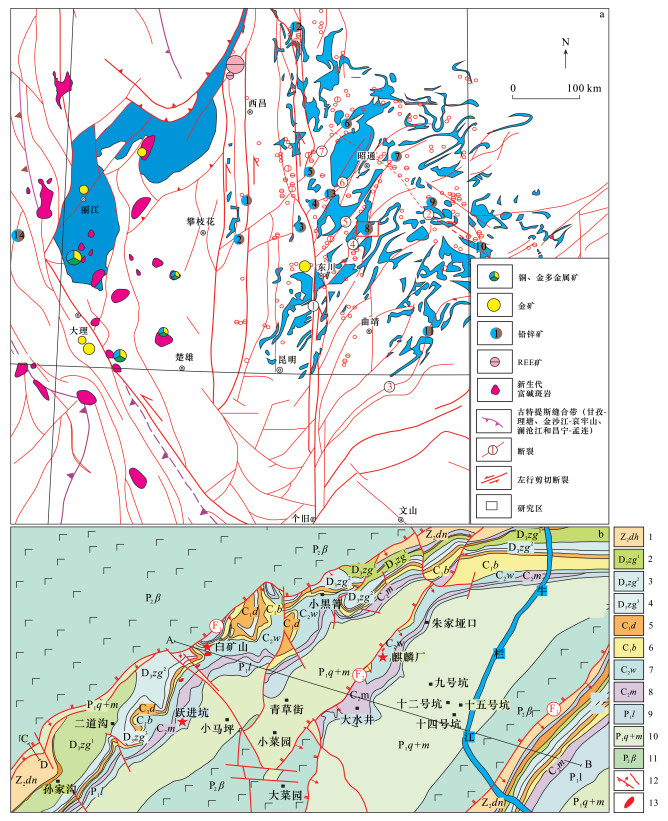
 下载:
下载:
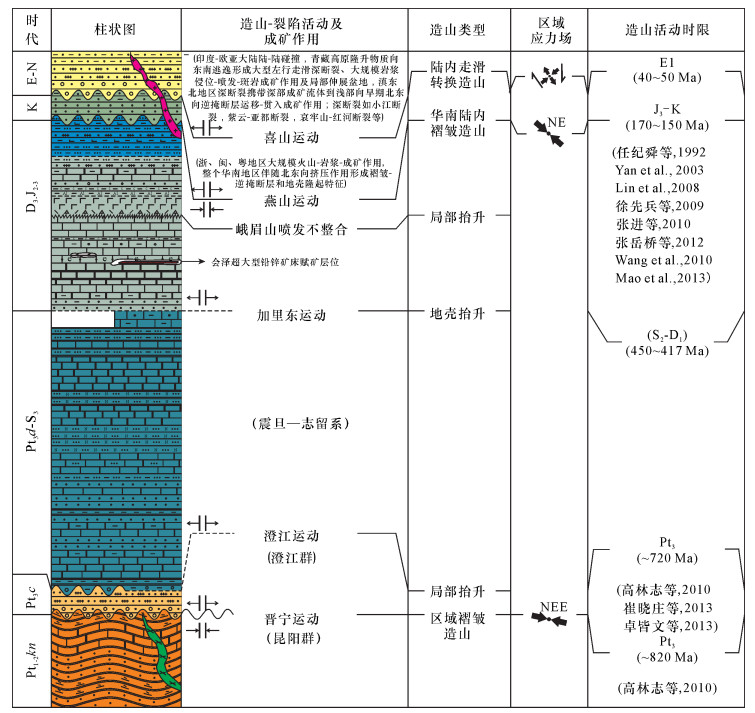
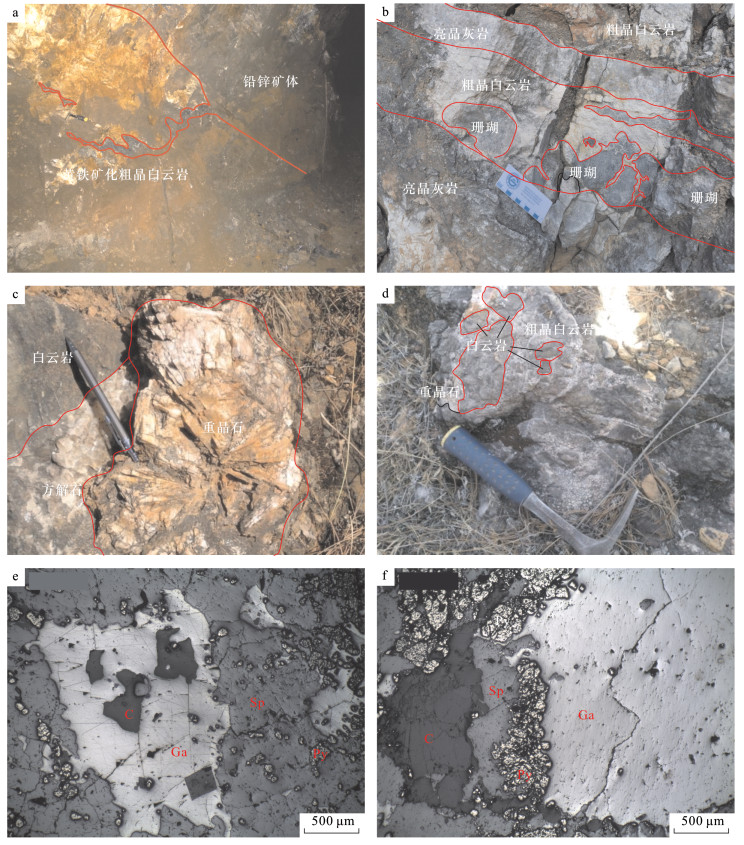
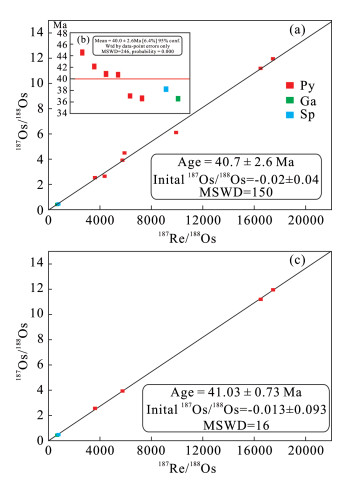
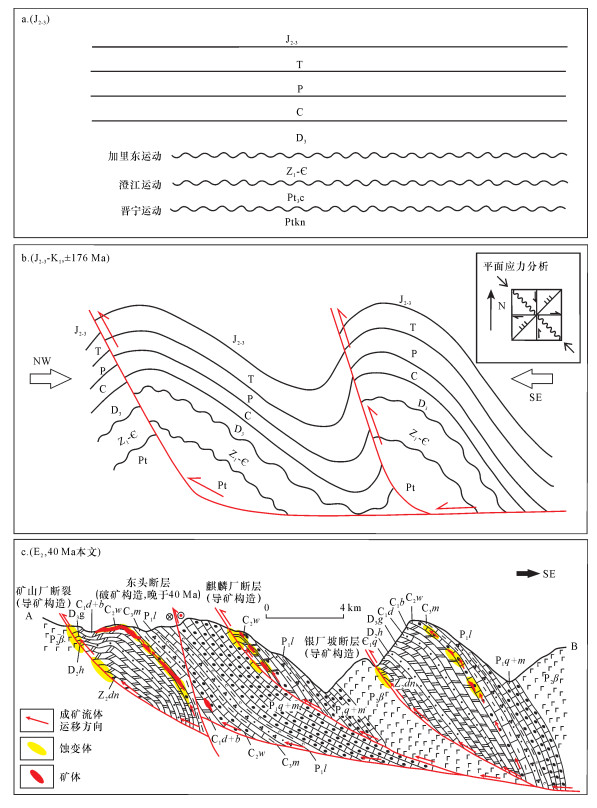
 京公网安备 11010202008159号
京公网安备 11010202008159号